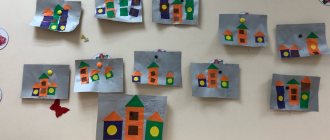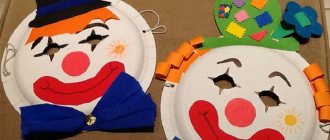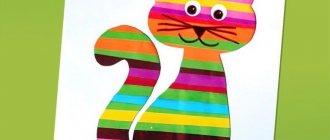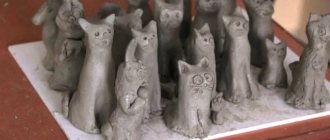Svetlana Aleksandrovna Mazhova
Summary of the lesson on the application “Gift for Dad - Tools” for children of the senior group
Topic: " Gift for dad - tools ."
Goal: Create conditions for consolidating and generalizing knowledge about working tools and their purpose .
Tasks :
Educational: clarify, expand and activate children’s vocabulary on the topic “Tools and tools ; consolidate the ability to cut a strip folded in half (several times)
to obtain a symmetrical shape, figures of the same size; consolidate the ability to cut a circle from a square, an oval from a rectangle
Developmental: develop children creative imagination, attention, observation, ability to draw logical conclusions; develop the ability to coordinate your actions with the work of the entire team
Educational: cultivate a sense of goodwill, responsibility and cooperation; to form a positive attitude of children towards the teacher and towards each other.
Methods and techniques:
Visual (show, demonstration)
;
Verbal (literary word, conversation, question-answer)
;
Gaming (didactic game)
Practical (completing the task)
Pedagogical technologies: socio-game technologies
Materials: Whatman paper, colored paper of different formats and colors, scissors, glue, napkins for work. Toy tools : hacksaw, hammer, rake, screwdriver, pliers, thimble, tool , letter.
Preliminary work: Reading works: S. Marshak “Master - Lomaster”
,
“How a plane made a plane”
;
examination of tools ; writing a descriptive story; construction with construction kit parts (with screwdriver, wrench)
The benefits of applications for children's development
It is recommended to engage in paper crafts from a very early age.
By the age of 2, a child is ready to confidently perform simple adult tasks in the creative field.
Creating applications helps develop fine motor skills and also contributes to the all-round development of the child.
- All actions of the work process are not only studied and reinforced, but also talked to the baby, giving him new knowledge about the world around him.
- This process is also useful for older children. As a result of the work, imagination and logic develop.
- Even adults will benefit from paper art.
Creative work will help you have fun, switch your mind, and support brain function without overstrain.
Ideas for making paper appliques
It's easy to create paper appliques for kids. They don't require any effort. The operating principle is easy to understand even for the little ones.
Older children, as well as adults, should not despair of enjoying the creative process using paper. There are more complex technologies that are worthy of attention.
Elementary pictures for kids
If, together with the kids, we learn to make pictures from paper with our own hands using the appliqué principle, then we need to start with the simplest. The child needs to be explained the procedure for creating such a craft.
- To begin with, the baby is given ready-made paper parts. It is better to train using material with an adhesive layer.
- The child just needs to assemble the components into a single object.
- Before gluing, you can show how the result should look by assembling the picture without fixing it.
- It is better to offer large, understandable details to kids. It is better to set an example picture before your eyes.
There are many ready-made creativity kits on sale now. They contain everything you need to create crafts. The advantage of this option: there is no need for parents to do anything on their own in preparation for the creative process. Ready-made sets are usually selected taking into account the age of users.
Simple three-dimensional pictures
You don't need templates to make simple three-dimensional pictures. It is enough to understand how to get the expected result. There are different techniques for creating this effect.
You can create a shape by gluing several identical parts in halves.
- You will get a volume effect if the elements of the object are glued not directly to the base, but with the help of “accordions” made of paper.
- You can partially, rather than completely, attach parts. The components can be folded and glued on top of each other.
The object can be folded according to the origami principle and partially glued to the base. There are many ways, each of which is simple and accessible to most who want to create.
Application options for school-age children
It is also useful and interesting for older children to make paper appliqués. At the same time, we must not forget that elementary variations no longer suit them. To maintain interest in creativity, it is necessary to develop and complicate tasks.
Appliques with monosyllabic, large details can be left in the past. For work, it is better to take options that require more effort.
It could be:
- Complex processing of parts;
- A large number of elements;
- The need for logical, creative thinking.
You can come up with a task using your child’s favorite theme. It will be interesting to get results by finding solutions to puzzles or completing quests. If it’s difficult to plan a task on your own, you can use ready-made ideas.
Paper applications for adults
It happens that childhood is over, but the desire to create using paper has not disappeared. In this case, there is no need to restrain your creative impulses. It is enough to choose a suitable task to implement your own requests.
- You can just use your imagination and work with your hands.
- It is possible to create decor, a gift or other useful item.
- To work, you can use complex, unusual techniques. Adults can understand the intricacies of any process.
Both children and adults can make paper applications. It's a simple but fun process. Everyone will enjoy creating paintings with a minimum of cost and effort. The result will delight and inspire new creative experiments.
Variety of paper applications
Paper applications can be different. This is not just simply gluing cut-out parts onto a base. This technology is elementary and best suited for the little ones. Those who are older can experiment.
You can easily create a beautiful applique from pieces of paper rolled into balls or strips twisted using the quilling technique. Crafts can be made voluminous. There are different ways to achieve this effect.
There is an option for both children and adults. Interesting paper applications can be made using complex cutting. In this case, it is easy to create complex elegant paintings.
Material
The application itself does not require any time-consuming search for the necessary components. They were given by nature itself and partly by man. All the natural materials necessary for creativity can be found... just by going outside. Here you go:
- leaves;
- pebbles;
- shells;
- berries, etc.
In addition to the above components, there are also artificial materials created by man. It is thanks to them, for example, that you can create a beautiful applique craft from colored paper.
In general, such materials (except for the mentioned paper) include:
- colored fabric;
- beads;
- multi-colored beads;
- buttons, etc.
Using these elements and using imagination, a creative person can create something special, something that can attract the attention of other people.
What activities should you do with your child to teach him appliqué?
First give him a strip of paper and help him make the grass, that is, the cuts. From another strip you can make bricks or cubes. To do this you need to cut the strip completely.
Teach your preschooler to use glue, both liquid and solid. Show that glue can be applied to paper in different ways. You can glue the paper completely and along the edges and with dots.
Then you can move on to more complex figures. Teach him to cut out the shapes that make up most objects. For example, a triangle can be obtained by cutting a square diagonally (you get a sail). A trapezoid will turn out if you cut off the corners of a rectangle (you will get the roof of the house). A circle can be obtained if the corners of a square are gradually cut off by rounding (this is how you can get the sun or an apple). That is, strive to turn all activities into an entertaining game.
When folding paper, children do not pay attention to the position of the corners of the sheet of paper. You need to show the children that it will be correct to fold the corners and then use your fingers or palms to follow the fold line. Pay attention to this point.
The application has several stages of work, each of which is performed in turn. Before cutting, it is very important to see in your mind what the end result will be. Only after this you need to start cutting. You may even have to sketch out the outline of the image first. And you need to cut it out of a piece of paper that fits either in size or shape to the image that you have in mind. And already working with scissors, children should imagine what should happen. To develop such abilities in children, offer them tasks with obvious solutions. For example, if you give a child one small square of paper and one rectangle and ask him to cut out a pear and a berry, then he should imagine the result himself and realize that it is easier to cut a pear from a rectangle, and a berry from a small square.
Plot
Thanks to the universal materials used in the work, absolutely any theme can be used in applique crafts for children. It says here what human imagination is enough for.
Most often, the basis of the work is based on such subjects as:
- the story of a cartoon character;
- description of animals;
- favorite toy;
- the beauty of the natural world;
- New Year's or other holidays.
These stories are only a tiny part of what can be composed. Having an inquisitive mind, a person can create a story that everyone will be delighted with.








